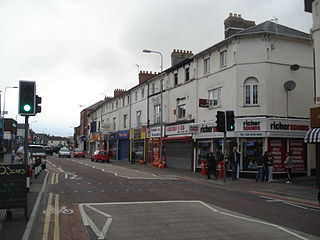
Roath is a district and community to the north-east of the city centre of Cardiff, capital of Wales. The area is mostly covered by the Plasnewydd electoral ward, and stretches from Adamsdown in the south to Roath Park in the north.

Splott is a district and community in the south of the city of Cardiff, capital of Wales, just east of the city centre. It was built up in the late 19th century on the land of two farms of the same name: Upper Splott and Lower Splott Farms. Splott is characterised by its once vast steelworks and rows of tightly knit terraced houses. The suburb of Splott falls into the Splott electoral ward.

Adamsdown is an inner city area and community in the south of Cardiff, the capital city of Wales. Adamsdown is generally located between Newport Road, to the north and the mainline railway to the south. The area includes Cardiff Prison, Cardiff Magistrates' Court, Cardiff Royal Infirmary, a University of South Wales campus, and many streets of residential housing. There are two primary schools in the area Adamsdown Primary School and Tredegarville Primary School.

Canton is an inner-city district and community in the west of Cardiff, capital of Wales, lying 2 miles (3.2 km) west of the city's civic centre. It is located adjacent to Pontcanna. Canton is one of the most ethnically diverse of Cardiff's suburbs, with a significant Pakistani and Indian population. The total population of Canton increased to 14,304 at the 2011 census. It is also the most Welsh-speaking district of central Cardiff, with 19.1% of the population speaking Welsh.

The Diocese of Llandaff is an Anglican diocese that traces its roots to pre-Reformation times as heir of a Catholic bishopric. It is headed by the Bishop of Llandaff, whose seat is located at the Cathedral Church of Saint Peter and Saint Paul in Llandaff, a suburb of Cardiff. It currently covers most of the former Welsh county of Glamorgan, but once stretched from the River Towy to the middle of the Wye Valley.

Grangetown is a district and community in the south of Cardiff, capital of Wales. It is one of the largest districts in the south of the city and is bordered by Riverside, Canton and Butetown. The River Taff winds its way through the area. Adjacent to the city's Cardiff Bay area, Grangetown is experiencing a period of gentrification and improvements in its infrastructure. Its population as of 2011 was 19,385 in 8,261 households. One of the "five towns of Cardiff", the others are Butetown, Crockherbtown, Newtown and Temperance Town.

The Mansion House, located on Richmond Road in Cardiff, was the official residence of the Lord Mayor of Cardiff until 1971. It was listed Grade II by Cadw in May 2002.

West Grove is a road in Roath, Cardiff, Wales. It is situated off Newport Road. The Queen's Buildings of Cardiff University, Kings Monkton School and the former West Grove Unitarian Church are all located in West Grove. The Mansion House is officially in Richmond Road, but it is at the extreme end of West Grove and dominates the northern end.

St John the Baptist Church is a Grade I listed parish church in Cardiff, Wales. Other than Cardiff Castle, it is the only medieval building in the city centre.

Architecture in Cardiff, the capital city of Wales, dates from Norman times to the present day. Its urban fabric is largely Victorian and later, reflecting Cardiff's rise to prosperity as a major coal port in the 19th century. No single building style is associated with Cardiff, but the city centre retains several 19th and early 20th century shopping arcades.
The Vale of Glamorgan has 740 listed buildings of which 4% are Grade I listed, 10% Grade II* listed and remainder Grade II listed.

There are around 1,000 listed buildings in Cardiff, the capital city of Wales. A listed building is one considered to be of special architectural, historical or cultural significance, which is protected from being demolished, extended or altered, unless special permission is granted by the relevant planning authorities. The Welsh Government makes decisions on individual cases, taking advice from the heritage agency Cadw, the Royal Commission on the Ancient and Historical Monuments of Wales and local councils.

St German's Church is a nineteenth-century Church in Wales parish church in Adamsdown, Cardiff, Wales dedicated to St Germanus of Auxerre,. The building, located on the corner of Star Street and Metal Street, is a Grade I Listed building.

Habershon & Fawckner or Habershon, Pite & Fawckner was a British architectural practice active in England and Wales from the 1860s, particularly in Cardiff and the South Wales area. They had had offices in London, Cardiff and Newport, designing a large number of houses, villas and non-conformist chapels.

Frank Roper was a British sculptor and stained-glass artist who undertook commissions for churches and cathedrals across Wales and England.

The Church of St Andrew and St Teilo is a Church in Wales church, located in Cathays, Cardiff. In 2020 the church was relaunched as Citizen Church, with a mission to serve students and young professionals.

St Peter's Church, Roath is the oldest surviving Roman Catholic church in Cardiff, the capital of Wales. It is administered by the Rosminians.

St Joseph's Church, is a Roman Catholic church in Cardiff, Wales. It is administered by the Rosminians. It serves the areas of Gabalfa, Cathays, and Maindy.




















